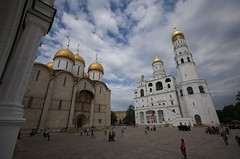Â
Visited the State History Museum in Moscow, it’s extremely typical in terms of the exhibits, though with some quite fantastic external and internal architecture – each room has a different theme, concept or historical inspiration. The exhibits commence with prehistoric artifacts (flint axe heads) and progress through to nomadic times, then on to the Imperial period and Mongol invasion and occupation. The entire upper floor is devoted to costumes, regalia and pieces from the Romanov era onwards, and I paid it little heed, since there’s almost no interpretation in English and visually it seems almost indistinguishable from European equivalents ((presumably that was the foremost intention of the designers)). The funniest part by far was a comment, in the English-language interpretation attached to a paleolithic room, about early prehistoric social and family groups being the ‘first instance of social equality and collectivism at work’. Ummm.
Â
Â
On to St Basil’s, actually a misnomer. The exterior is well photographed of course, but the whole building seems much smaller in real-life, and the interior lacks the great open space of St Paul’s or Notre Dame – you ascend a narrow staircase from a ground floor of vaults and chapels, to a main floor which seems like a warren of chambers, the largest perhaps eight metres in breadth – but soaring upwards twice or three times that, with light pouring in. The largest chamber contained a four part male choir whose singing reverberated beautifully inside the structure.
Â
Lunch was at a up-market cafeteria style eatery called ‘Moo-Moo’. The food is good, but the decor is dubious, with huge Fresian prints on the menus, tables, walls and anywhere else handy. Tolon-tolon flashbacks ensued.
Then on to the Kremlin proper, which is a curious mix of still highly-official buildings, such as the official residence of the president, and public spaces. The former Senate has been turned into a theatre used for opera and ballet. The main interest for tourists is the four ornate (gilded) Orthodox churches, with stunningly gaudy interiors, raised to the greater glory of whoever was running the country at the time. Well, there’s two more tourist traps – a giant useless broken bell, and a giant useless cannon, with over-sized balls.
Finally, a stroll down the Arbat, a pedestriansed and tourist-friendly shopping street, with many portrait-drawers and purveyours of Russian dolls. Also a set of stalls in a cluster, each with a person and a small ornate dog, heavily groomed and ‘dressed’. I was extremely unclear what service was being offered – the dog, the dog’s offspring, or simply a chance to hold the dog.


